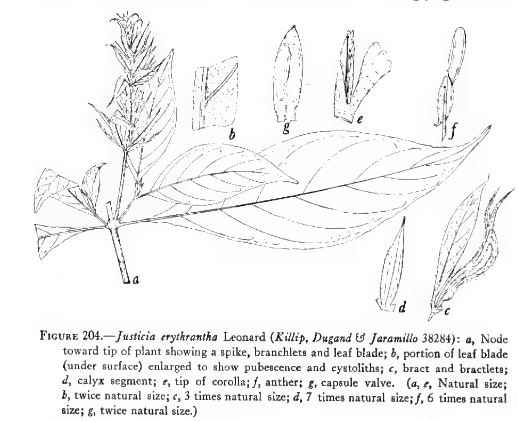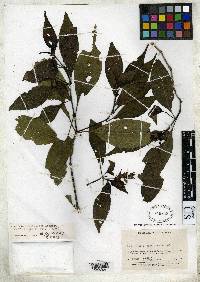
Neotropical Flora
|
Family: Acanthaceae
|
Shrubs up to 1.5 meters high; stems subterete, glabrous or the nodes minutely and sparingly strigose, the cystoliths minute and subpunctiform; leaf blades oblong-ovate to ovate, up to 14 cm. long and 4.5 cm. wide, acute to acuminate or short-acuminate, narrowed at base, rather firm, entire or undulate, the axils of the lower surface pilose, otherwise glabrous or minutely and sparingly strigose, the hairs confined chiefly to the costa and lateral veins (7 or 8 pairs), the venation rather obscure, the cystoliths minute (about 0.08 mm. long), often obscure; flowers borne in terminal and axillary spikes up to 6 cm. long and about 1.5 cm. broad, the peduncles up to 2 cm. long, subquadrangular, more or less flattened, glabrous or sparingly and minutely strigose, the rachis puberulous, the hairs upwardly curved, up to 0.16 mm. long; bracts lanceolate, 10 to 12 mm. long, 3 to 4 mm. wide, acuminate, narrowed at base, rather thin and veiny (the costa prominent), more or less minutely glandular-papillose, rather spar- ingly ciliate, the hairs 0.2-0.4 mm. long; bractlets linear-lanceolate, about 9 mm. long and 1 mm. wide, rather sparingly glandular-puberulous with a few larger eglandular hairs intermixed with the smaller ones, the margins ciliate with hairs up to 0.45 mm. long; calyx 4 mm. long, the segments lanceolate, 3 mm. long, 0.75 mm. wide, acute, thin, sparingly glandular-papillose and like the bracts and bractlets with a few longer eglandular hairs intermixed, the margins ciliolate with hairs about 0.13 mm. long; corolla red, about 3 cm. long, finely and rather sparingly pubescent, the hairs spreading, straight or slightly curved, up to 0.16 mm. long, the tube 2.5 mm. broad at base, narrowed to 1.75 mm. at 3 mm. above base, thence gradually enlarged to 3.5 mm. at mouth, the upper lip erect, oblong-ovate, 17 mm. long and 8 mm. wide at base, the tip bilobate, the lobes about 0.5 mm. long and broad, rounded, the lower lip more or less spreading, cuneate, 7 mm. wide at base of the lobes, these 3, ovate, about 3.5 mm. long, rounded; stamens reaching within 2 mm. of tip of the upper lip of the corolla and partially enfolded by it, the anthers about 4 mm. long, the lobes superposed, vertically attached, their tips overlapping about 0.5 mm., the base of the lower lobe apiculate or caudate, the tail about 0.25 mm. long; style reaching within 0.5 mm. of the tip of the upper lip of the corolla, the stigma minute and conical; capsules about 1 cm. long, 4 mm. wide and 2.5 mm. thick, 4-seeded, glabrous, the tip obtuse, the solid basal portion 3.5 mm. long and 3 mm. wide; retinacula about 2 mm. long and 0.5 mm. wide, curved, the tip rounded and erose; seeds cordate, flattened, brown, about 2.5 mm. long and broad, muricate. Type in the U. S. National Herbarium, No. 1855848, collected along stream in woods at Hacienda El Cucharo, between Tocaima and Pubenza, Department of Cundinamarca, Colombia, 350 meters altitude, May 7, 1944, by E. P. Killip, A. Dugand and R. Jaramillo (No. 38284). Also of this species are Francis W. Pennell's No. 2831 (GH, NY, US), collected in woods at Natural Bridge, Pandi, Department of Cundinamarca, 800 to 900 meters altitude, December 1-3, 1917; Triana's specimen (K) collected in the "Province of Cauca" 1853, Oscar Haught's No. 2396, collected in forest near the mouth of the Río Totare, Department of Tolima, about 300 meters altitude, October 28, 1938, and Lorenzo Uribe-Uribe's No. 2309, collected between Tocaima and Pubenza, Cundinamarca. Characterizing Justicia erythrantha are the rather short spikes, the ovate acuminate bracts, and the red corollas. The specific epithet is from the Greek words eputhpós, red, and areos, flower. |
Powered by Symbiota.



